Flex Time Manager: Introduction-
Table of Contents
The traditional time of 9.00 a.m.–5.00 p.m. has long been a part of the work culture of any office or business organization. This work culture includes the process of working within the prescribed time, at a fixed place, and with a routine. In the present times, under a busy lifestyle, the lifestyle, responsibilities, and working style of every person are different in the competitive world. In such a difficult situation, it is no longer practical and possible for everyone, under the traditional working style, to work at the same time, at the same place, due to the time spent in traffic and the imbalance in personal and professional life.
To solve all these problems, Flex Time Manager is a method that makes the entire traditional work style flexible, streamlined, and transparent.
What is Flex Time?
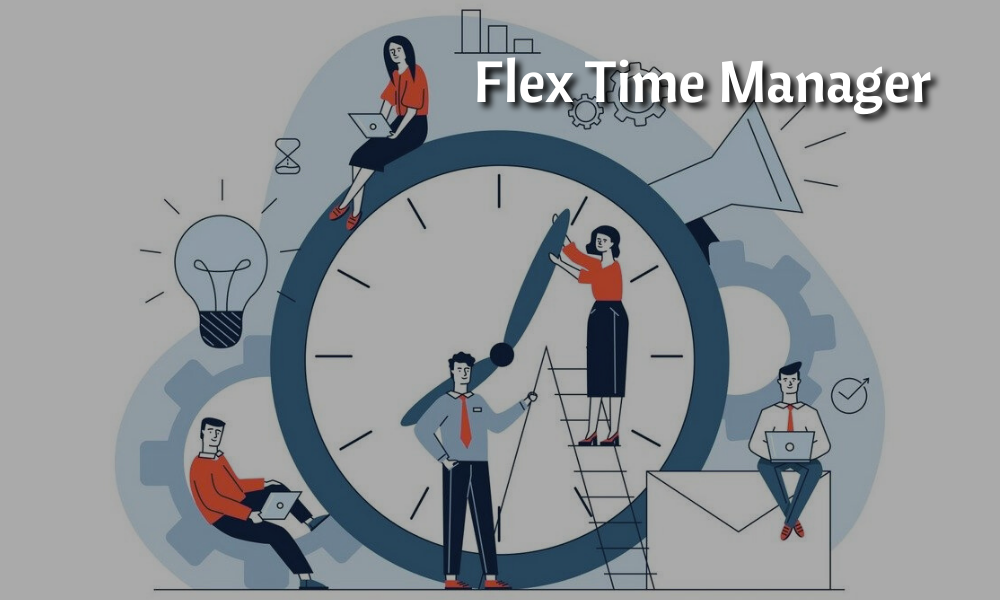
Flex time is a practice in which all team members or employees are given the freedom to schedule their work time according to their personal convenience, health, and daily task preferences, but to adhere to the work time set by him and the “core time” required by the organization. It not only provides physical and mental balance to the employee but also increases productivity and satisfaction for the organization. Flex time, mainly divided into two parts.
A- Core Time- The fixed time in which the attendance of all employees is compulsory, so that meetings, teamwork, and necessary coordination work can be done smoothly. For example, from 11.00 am to 2.00 pm.
B- Flexible time- The remaining time, other than the core time, in which the employees can complete the work as per their convenience, by doing the work set by them. For example, one employee can start work at 7.00 a.m. and finish it by 2.00 p.m., while another may start at 10.00 a.m. and finish it by 4.00 p.m.
In the last few years, due to the global pandemic like COVID-19, due to the entire technological advancement, and the entire process of the work environment, there has been a major change in the work culture. Globalization, remote work, and the increasing use of digital tools have completely changed the entire traditional working system.
Now people are beginning to see the result of the work, more than just the working time. Amid this change, the concept of the flex time manager has become increasingly popular to streamline the entire process. It is a system that helps to flexibly streamline the work style, create schedules, track time, and prepare reports. It gives freedom to all employees to choose the time and place of work as per their convenience, in addition to the prescribed core time. This improves the work balance, increases productivity, and also gives the organization a more skilled workforce.
The major objective of this blog is to give detailed information about Flex Time Manager. Such as What is Flex Time Manager, Need, Role, Main Functions, Benefits, Challenges and Solutions, Steps to Implement, Tips for Success, Real-Life Examples, Its Importance in the Future, etc.
Flex Time Manager: Requirement-
In today’s hectic lifestyle, a flex time manager has become not just a convenience but also a necessity. Several important reasons for this are as follows.
1. Changes in Lifestyle and Work Balance-

At this time, people have started giving priority not only to jobs but also to family, health, and personal development. Flex Time Manager helps employees to have a better balance of their time, thereby reducing mental stress and increasing the quality of life.
2. Global Teams and Different Time Zones–

In many multinational companies, employees from different countries work together. In the traditional working hours of 9.00 a.m.–5.00 p.m., it is impossible to reconcile everyone at the same time. With a flex time manager, team members can contribute to each other according to their time zone, which increases the spirit of collaboration and productivity among themselves.
3. Technological Development and Remote Work Culture–
Cloud tools, video conferencing, and project management software have made it easier to work from multiple countries at once.
4. Satisfaction and Durability of Employees–
Under flex time managers, employees feel that the organization understands their needs and gives them importance. This experience not only increases their satisfaction but also helps in sustaining talented employees for a long time.
Who is in the role of Flex Time Manager?
The role of a flex time manager can be anything from a person, software, or policy model whose purpose is to effectively manage flex time in the organization. It is not limited to monitoring time. It also ensures team coordination, functionality, and transparent communication.
Flex Time Manager as Person- The role of flex time manager, a manager appointed in the organization as the person who oversees flex time schedules, team collaboration, and time compliance.
As Flex Time Manager Software- Flex Time Manager Role As Software, tools like Clockify, Zoho People, and BambooHR automate and operate scheduling, time tracking, and reporting.
As a Flex Time Manager Policy- In the role of a flex time manager, a clear framework of the organization, in which the rules of flex time, permissible limits, and methods of performance appraisal are prescribed.
Flex Time Manager: Role in Organization-

The role of a flex time manager in the organization is varied. For example:
1- Overseeing employees’ working hours and availability, and time compliance.
2- Operating 2-core time and flexible time adherence.
3- Team collaboration and organizing meeting schedules.
4- Time usage, productivity, and output monitoring.
5- For the improvement of rules, providing data and feedback.
Limitations of the work–
1. Schedule Management- Planning who will act, when, and from where.
2-Time Tracking- Tracking working hours and delivery timeline.
3-Reporting and Analytics- Preparation, preparation of reports on performance, time utilization, and team efficiency.
4. Communication Facility – To ensure transparent and timely communication in the team.
Difference between Flex Time Manager and Traditional Manager
Aspect
Working Hours
Focus
Tools
Communication
Traditional Manager
Adherence to the fixed 9-5 schedule
Attendance and punctuality
Manual tracking, meetings
Face-to-face meeting
Flex Time Manager
Coordination of flexible working hours
Results and productivity
Digital Tools, Automation
Hybrid/Virtual Communication Channels
The flex time manager is thus an important pillar of the modern workplace, which goes beyond the limitations of traditional management and adopts a new approach of flexibility, efficiency, and result-oriented management.
Flex Time Manager: Key Functions-
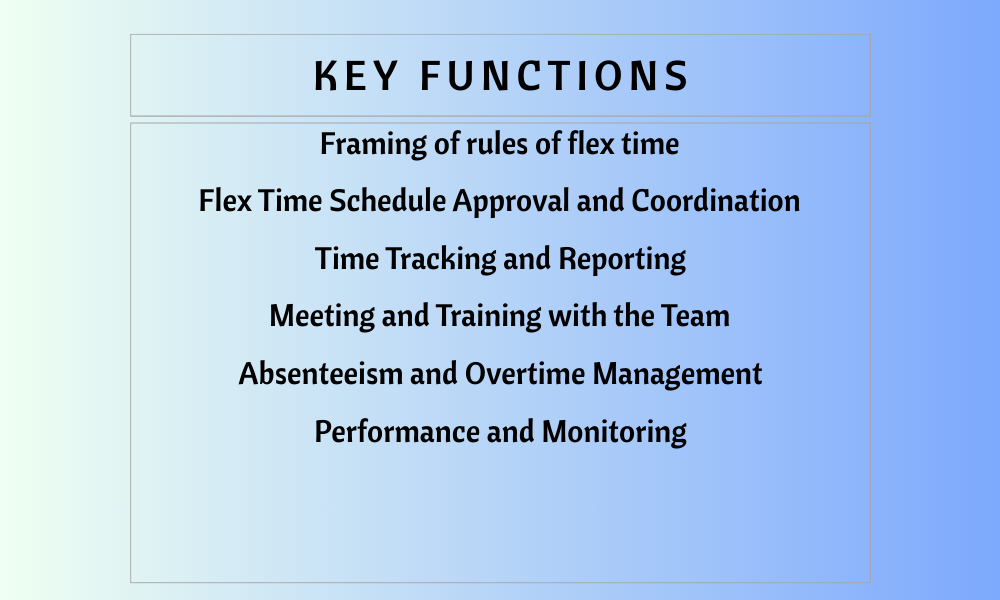
The main objective of a flex time manager is to implement flexible working hours in the organization in a streamlined and effective manner. For this, he has to follow a variety of responsibilities, which balance both the convenience of the employees and the productivity of the organization.
1. Framing of rules of flex time-
Before issuing flex time in the organization, it is necessary to formulate clear rules. It sets out core time, flex time, reporting procedures, and compliance rules. The flex time manager tailors these policies in line with the organization’s requirements and legal provisions.
2. Flex Time Schedule Approval and Coordination-
It is the responsibility of the flex time manager to review and approve the flex schedule proposed by employees. He ensures that all team members coordinate their flex time schedules in such a way that project deadlines and meetings are not affected.
3. Time Tracking and Reporting-
Using tools like Clockify, Zoho People, or BambooHR, all employees’ work hours are tracked. Reports are generated from these data, which help the management to assess productivity and time utilization.
4. Meeting and Training with the Team-
Successful implementation of flex time requires all employees to have a meeting and training with the team about its procedures and rules. For this, the Flex Time Manager regularly communicates with the team and resolves problems related to it.
5. Absenteeism and Overtime Management-
In the event of any employee’s absence or extra working hours, keeping records and making necessary adjustments is also the function of the flex time manager. This leads to balanced use of all resources.
6. Performance and Monitoring-
Even in flexible timings, it is important to ensure that the quality of work and timely delivery are maintained. The flex time manager sets performance parameters and reviews them periodically.
Thus, a flex time manager plays the role of a policy-maker, coordinator, and performance controller, enabling the organization to reap the benefits of both flexibility and results.
Flex Time Manager: Advantages-
Flex time not only provides flexibility of time, but it also brings many benefits for both employees and the organization. It has become an important tool of productivity, satisfaction, and long-term success in the modern work system.
Benefits for Employee-
1. Work Balance–

Flex time managers give employees a chance to strike a better balance in their personal and professional lives. They can make time for family, health, and personal interests, which reduces stress and increases the quality of work in life.
2. Time Saving-

Through this, employees can avoid traffic and save time commuting. They can spend their time relaxing, learning, or engaging in other creative activities.
3. Increased self-confidence and productivity-

When employees work under a flex time manager, they are more focused and energetic towards their work. This not only increases their confidence but also increases satisfaction with the task.
Benefits for the Organization-
1. Retaining Talent-
Organizations that offer flex time can keep their employees engaged for a long time. Especially the new generation of professionals considers flex time as an important criterion for choosing a job.
2. Absenteeism and Cost Reduction-
Flexible timings reduce the need for employees to take sudden holidays, thereby decreasing absenteeism and increasing productivity.
3. Better Team Output-

Satisfied and motivated employees perform better in teamwork. By taking advantage of flex time, they complete their work on time and also maintain quality.
A flex time manager, therefore, not only provides independence and balance to his employees, but also makes the organization more stable, productive, and competitive.
Flex Time Manager: Challenges and Solutions-
However, Flex Time Manager is a powerful and effective solution to modern work practices. But there are many practical challenges at the time of issuing it. If these are not resolved in time, it turns into a flex time chaos.
Key Challenges:
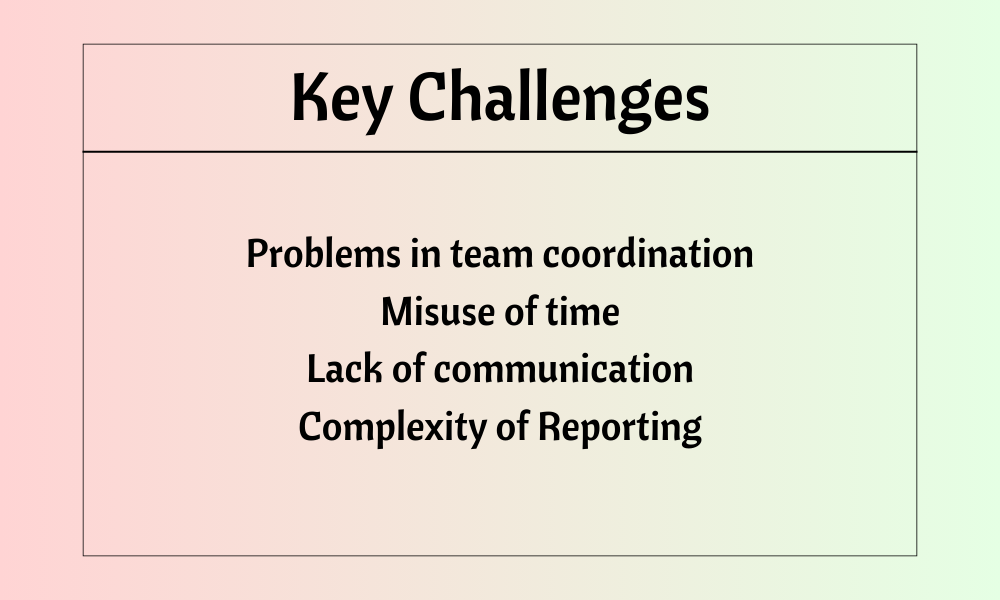
1. Problems in team coordination–
When team members work at different times and places, it becomes extremely difficult to coordinate meetings, decision-making, and collaborative work.
2. Misuse of time-
Some employees do not utilize flexible time properly and keep procrastinating work, which affects both deadlines and quality.
3. Lack of communication-
Not being online or in the office at the same time can delay communication and hinder the exchange of information.
4. Complexity of Reporting-
Tracking the work hours, progress, and attendance of employees working in different schedules becomes extremely difficult with traditional methods.
Solution by Flex Time Manager-
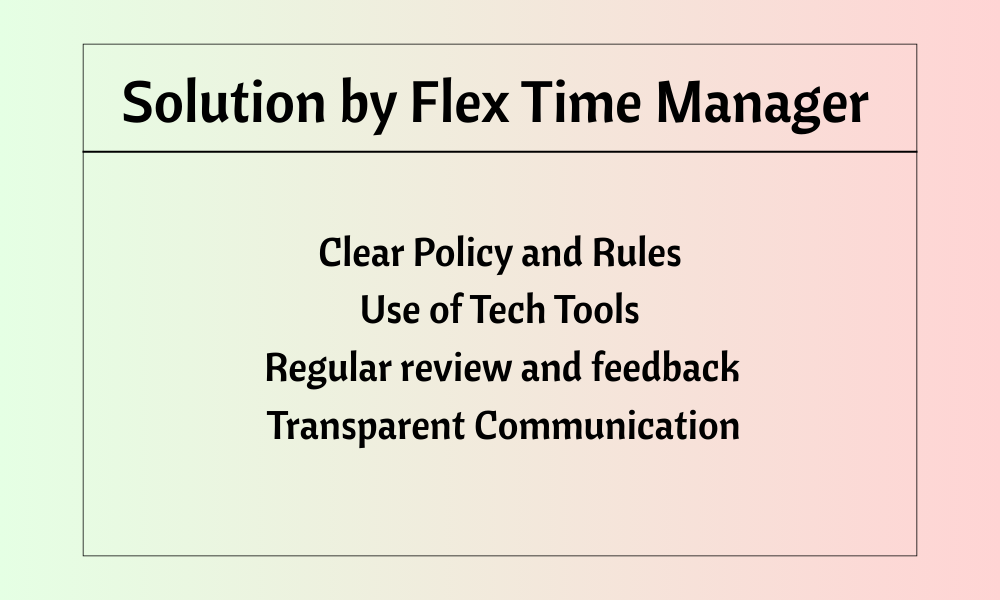
1- Clear Policy and Rules-
Core time, total working hours, leave procedure, and approval rules should be set in advance, so that expectations are clear to all.
2- Use of Tech Tools-
Task management can be simplified by using time tracking, scheduling, and project management tools, such as Clockify, Zoho People, and Asana.
3- Regular review and feedback-
On a weekly or monthly time basis, review the data to assess how effective the flex time policy is and what areas need improvement.
4- Transparent Communication-
Promote an open communication culture in the team, so that each member knows who, when, at what time, and what work is in progress.
Therefore, the success of a flex time manager lies not only in flexibility but also in discipline, correct use of technology, and transparent communication. A competent flex time manager can turn these challenges into opportunities.
Flex Time Manager: The Role of Technology-
Successful management of flex time managers does not depend only on policies, but also on the contribution of technology is very important. Modern tools and software not only track time and work but also make flex time more powerful and effective through data analysis, scheduling, and automation.
1. Time Tracking Software-
Software such as Clockify, BambooHR, and Zoho People accurately track employees’ work hours, breaks, and project time. This not only increases transparency but also eases payroll and performance evaluations.
2. Scheduling Tools-
Scheduling tools allow managers to plan teamwork in different time slots. These tools (like Google Calendar, Asana, and Trello) help the team adjust to core time and personal schedules.
3. Reporting and Analytics-
Reporting features in Flex Time Manager analyze the performance, time usage, and deadlines of various employees. Analytics data allows managers to decide which areas need improvement and which flex time strategy is delivering the best results.
4. Automation based on Artificial Intelligence-
Artificial Intelligence (AI) automates and streamlines many processes. For example, creating meeting slots based on availability, giving overtime alerts, or analyzing the working patterns of employees. This increases both the speed and accuracy of decision-making.
Flex Time Manager transforms from a simple time management tool to a data-driven, smart, and efficient solution that enhances both flexibility and productivity.
Flex Time Manager: Stages of issuance–
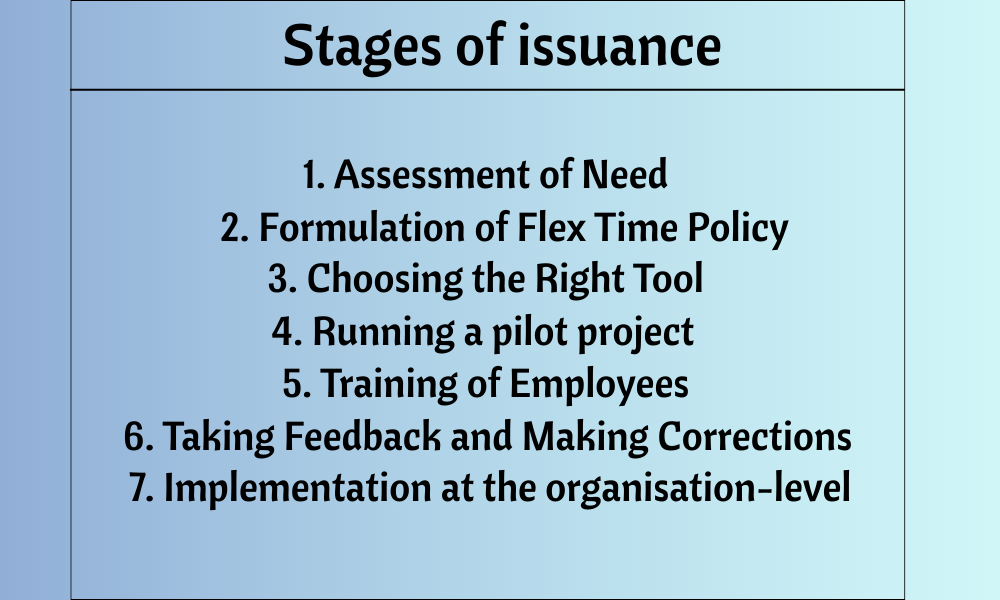
In any organization, a well-organized, well-thought-out, and stepwise strategy is required to successfully implement a flex time manager. It’s not just a matter of installing tech tools, but the process of adopting a new work culture. The main steps are given below.
1. Assessment of Need-
First of all, it is necessary to understand why flex time is needed in the organization. Are employees feeling a lack of work balance? Is there difficulty in coordination due to different time zones or remote work? This assessment makes it easier to choose the right policy and tools.
2. Formulation of Flex Time Policy-
Before implementing flex time, a clear policy has to be formulated, which should include core time and flexible hours, rules of leave and overtime, criteria for performance appraisal, etc. The policy must reach all employees in writing.
3. Choosing the Right Tool-
Choose flex time manager software suitable for time tracking, scheduling, and reporting, such as Clockify, a simple tool for small organizations, feature-rich tools for large organizations, such as BambooHR, or Zoho People.
4. Running a pilot project-
Before releasing it to the entire organization, run it on a trial basis in a department or team and see how the policy tools work in practice. Identify and address early challenges.
5. Training of Employees-
For this, give full information to all employees about the use and policies of the new system. Training through workshops, video tutorials, or demos. Teach managers and team leaders about the additional responsibilities and advanced features of the tools.
6. Taking Feedback and Making Corrections-
For this, take feedback from employees and managers after the pilot project. What tools are easy to use? Has time management and productivity improved? Make changes to policy or tools based on these responses.
7. Implementation at the organisation-level-
For this, when the system and policy are stabilized, release it to the entire organization. Provide continuous support during rollout. Keep updating the system by reviewing it from time to time.
Hence, the issuance of a flex time manager is a work culture change. If adopted with the right planning, techniques, and training, it can take both the productivity of the organization and the satisfaction of the employees to new heights.
Flex Time Manager: Helpful Resources-
If you want a personal flex schedule planner, I can help you. You can get a variety of Planners with the help of the latest website vijaybooks.store. Other blogs related to this are also available.
There is also another blog equivalent to this blog.
Flex Time Manager: Successful Tips-
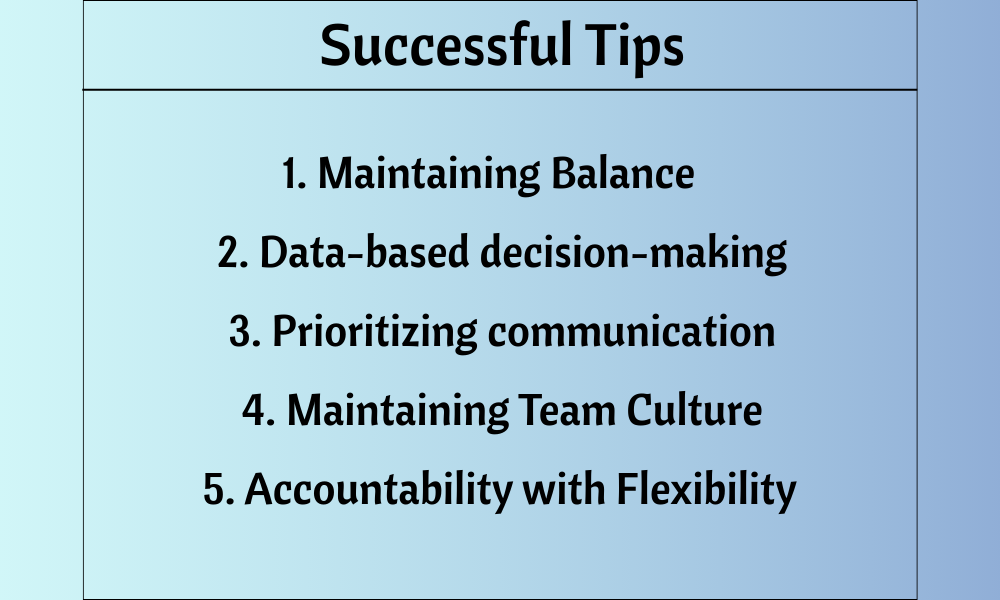
To make a flex time manager effective, it is not enough to give flexibility alone, but it is also necessary to have a successful management strategy. Below are some practical tips that can be beneficial for both the organization and the employees.
1. Maintaining Balance-
Flex time does not mean that discipline in work is lost. Keeping in mind the core time and deadlines, it is important to strike a balance for both individuals and organizations.
2. Data-based decision-making
For this, improve policies by analyzing data on employees’ work hours, project progress, and productivity. This ensures that the impact of flex time can be measured.
3. Prioritizing communication-
For this, maintain clear and timely communication in the team. Use messaging platforms, video calls, and scheduling tools to keep all members connected.
4. Maintaining Team Culture-
Despite the flexible schedule, team unity is essential. Virtual meetings, team-building activities, and regular checking are helpful.
5. Accountability with Flexibility-
For this, give time freedom to all employees, but also fix accountability towards the quality and timelines of their work.
Therefore, the basic mantra of a flex time manager is the right mix of independence, discipline, and communication. This not only increases efficiency but also increases trust and satisfaction in the team.
Flex Time Manager: Real-Life Examples-

The concept of the flex time manager is released in different areas according to their need and methodology. Below are some real examples, illustrating its diverse uses.
1. IT Company’s Flex Time Model–
For this, many IT companies, such as TCS and Infosys, allow employees to work for the rest of the hours as per their convenience, with the condition that the core time is available from 10.00 am to 3.00 pm. This model is especially successful in projects that have to work with clients from different time zones.
2. Shift-based flexibility in the healthcare sector-
For this, the shift system is adopted to provide 24×7 services in hospitals and clinics. But many institutions now allow doctors and nurses to shift shifts or mutually agree on timings, which reduces fatigue and maintains the quality of service.
3. Result-Based Methodology in Startups–
For this, many startup companies adopt a result-oriented work environment (ROWE), where work hours do not matter; only results matter. In this, employees decide the time according to their convenience, provided the targets and deadlines are met.
Therefore, it is clear from these examples that Flex Time is not a uniform model, but a flexible framework adapted to the nature of the field, culture, and work.
Flex Time Manager: Role in the Future-

In the coming years, Flex Time Manager will not just be a tool for time management, but will become a smart Artificial Intelligence (AI)- powered partner.
1. Artificial Intelligence (AI) and Machine Learning-
The algorithms will automatically generate schedules based on staff availability, productivity patterns, and project priorities. This will save time for manual planning and maximize the use of resources.
2. Integration into Virtual Workplace-
As workspaces are becoming cloud-based and virtual, Flex Time Manager will be integrated directly into collaborative tools like Microsoft Teams, Slack, and Zoom, so that scheduling, communication, and reporting can happen on a single platform.
3. Real-Time Performance Tracking-
Flex time managers in the future will track employees’ activities, project progress, and productivity in real-time, enabling instant feedback and decisions.
4. Importance in Hybrid Work Culture-
In the hybrid model, flex time will become the central means of maintaining a balance in manager, team attendance, meeting time, and collaborative tasks.
Hence, in the future, flex time managers will be a smart, integrated, and real-time decision-making system, making organizations more flexible, efficient, and competitive.
Flex Time Manager: Conclusion-
In today’s hectic lifestyle, the traditional working style of 9.00 am – 5.00 pm is gradually taking a backseat. Flexible work systems, such as flex time managers, are replacing it, which provide both freedom to employees and better productivity to organizations. Flex Time Manager not only streamlines time and schedules but also simplifies team coordination, task tracking, reporting, and the decision-making process. Whether it is a global project of IT companies, a personalized learning model of an education institution, or the shift management of healthcare, its impact is visible everywhere. In the long term, the system provides employees with the opportunity for work balance, stress reduction, and personal growth, while ensuring talent retention, cost reduction, and high-quality output for the organization.
Therefore, Flex Time Manager has become an essential tool of the modern workplace, which will play an important role in making the work culture even more flexible, efficient, and humane in the coming times.

